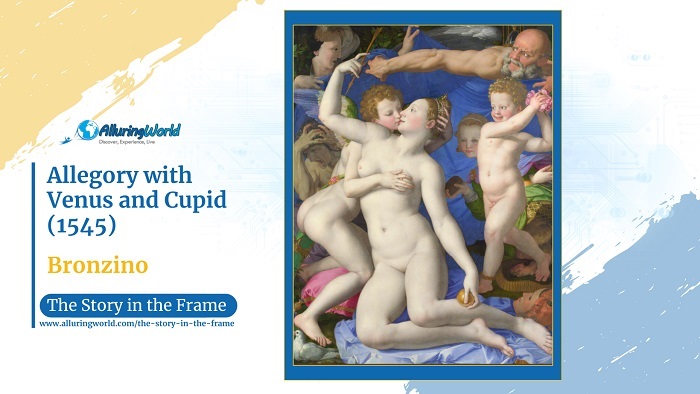Being one of the most enigmatic and provocative masterpieces of the Mannerist period, the Allegory with Venus and Cupid was painted around 1545 by Agnolo Bronzino for the Medici court, where the painting is filled with intricate symbolism, depicting a complex scene of love, deceit, and consequence. Often interpreted as a cautionary tale about the dangers of lust and the fleeting nature of pleasure, it showcases Bronzino’s signature style, which refers to exquisite detail, smooth surfaces, and elongated figures, and the work remains one of the most discussed and debated allegorical paintings in art history.
About the Painter:
Agnolo Bronzino (1503–1572) was an Italian Mannerist painter known for his refined, elegant portraits and allegorical compositions. As the court painter for the Medici family in Florence, he developed a distinctive style characterized by cool color palettes, precise details, and an almost porcelain-like rendering of human skin. His work was deeply intellectual, often incorporating complex symbolism and literary references, and his influence extended beyond his own time, shaping later artists of the Florentine school and cementing his reputation as one of the greatest painters of the late Renaissance.
Inspiration and Reasons Behind the Painting:
Commissioned by Cosimo I de’ Medici, Allegory with Venus and Cupid was likely intended as a gift for the French court of Francis I. The painting reflects the Mannerist fascination with intricate allegories, intellectual puzzles, and erotic themes because its precise meaning remains debated, but it is often interpreted as a warning against the consequences of unchecked passion, a celebration of love’s complexities, or a reflection on deceit and vanity. The Medici family, known for their appreciation of classical mythology and philosophy, may have sought to impress the French court with a sophisticated, layered work filled with hidden meanings.
What is Depicted in the Painting:
At the center of the composition, Venus and Cupid engage in an intimate, almost unsettling embrace. Venus, identified by her golden apple and exquisite beauty, kisses Cupid while removing an arrow from his quiver, and their unnatural closeness, along with Cupid’s twisted body and exaggerated pose, creates a sense of unease. Surrounding them are various symbolic figures: a young boy scattering rose petals (possibly representing Folly or Pleasure), a grotesque old woman with a mask (interpreted as Jealousy or Syphilis), a man with a theatrical mask (suggesting Deception), and a figure in the shadows with a distorted face (perhaps representing Time or Oblivion). In addition to all this, the background is quite rich, filled with cool, ethereal tones, enhancing the dreamlike, unsettling atmosphere of the painting.
Colors and Techniques:
Bronzino’s color palette is dominated by cool, almost icy tones, with pale blues, soft pinks, and delicate flesh tones creating a polished, porcelain-like effect. His use of sfumato and smooth, meticulous brushwork eliminates any visible brushstrokes, giving the figures an almost unnatural perfection. The sharp contrasts between light and shadow emphasize the theatricality of the composition, while the figures’ exaggerated poses and elongated limbs reflect the Mannerist preference for complexity and artificial elegance. The careful attention to textures, from the luminous quality of Venus’s skin to the rich fabrics and reflective surfaces, showcases Bronzino’s technical mastery.
Conclusion:
Overall, Allegory with Venus and Cupid remains a fascinating example of Mannerist art, blending beauty with unsettling ambiguity. Its intricate symbolism and polished execution continue to intrigue scholars and art lovers alike, prompting endless interpretations about love, deception, and the human condition. The painting’s influence can be seen in later allegorical works, and its striking imagery has ensured its place as one of the most memorable masterpieces of the Renaissance.

